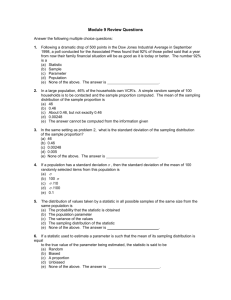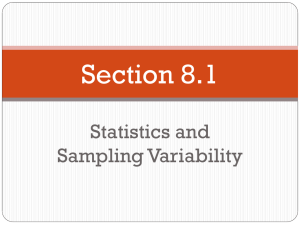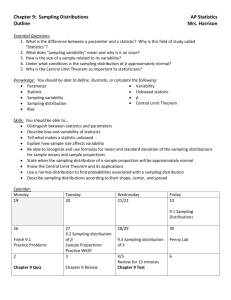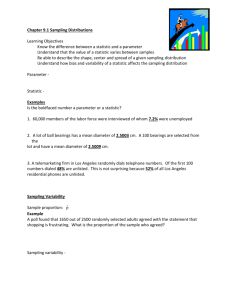Sampling Distribution of a Statistic
advertisement
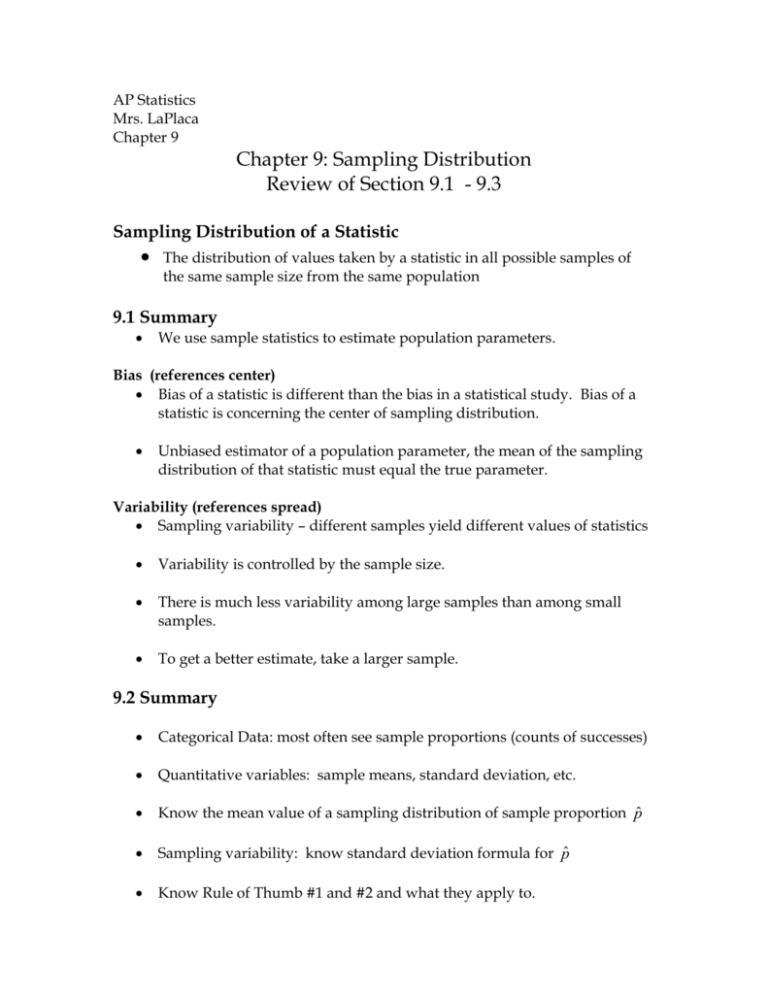
AP Statistics Mrs. LaPlaca Chapter 9 Chapter 9: Sampling Distribution Review of Section 9.1 - 9.3 Sampling Distribution of a Statistic The distribution of values taken by a statistic in all possible samples of the same sample size from the same population 9.1 Summary We use sample statistics to estimate population parameters. Bias (references center) Bias of a statistic is different than the bias in a statistical study. Bias of a statistic is concerning the center of sampling distribution. Unbiased estimator of a population parameter, the mean of the sampling distribution of that statistic must equal the true parameter. Variability (references spread) Sampling variability – different samples yield different values of statistics Variability is controlled by the sample size. There is much less variability among large samples than among small samples. To get a better estimate, take a larger sample. 9.2 Summary Categorical Data: most often see sample proportions (counts of successes) Quantitative variables: sample means, standard deviation, etc. Know the mean value of a sampling distribution of sample proportion p̂ Sampling variability: know standard deviation formula for p̂ Know Rule of Thumb #1 and #2 and what they apply to. 9.3 Summary Quantitative variables: sample means, standard deviation, etc. Know the mean value of a sample proportion X Sampling variability: know standard deviation formula for X Central Limit Theorem Few populations are normal, let alone exactly normal. However, it can be shown that no matter how the original population is distributed, if “n” (sample size) is large enough, then the set of sample means is approximately normally distributed. Sampling distribution of sample mean X is close to the normal æ s ö N ç m, ÷ è nø distribution Law of Large Numbers Draw independent observations at random from any population with finite mean m . As the number of observations drawn increase, the mean X of the observed values eventually approaches the mean m of the population. Averages are less variable than individual observations Averages are more normal than individual observations. Chapter 9: Practice Multiple Choice 1. A machine is designed to fill 16-ounce bottles of shampoo. When the machine is working properly, the mean amount poured into the bottles is 16.05 ounces with a standard deviation of 0.1 ounce. If four bottles are randomly selected each hour and the number of ounces in each bottle is measured, then 95% of the observations should occur in which interval? (a) 16.05 and 16.15 ounces (b) –.30 and +.30 ounces (c) 15.95 and 16.15 ounces (d) 15.90 and 16.20 ounces (e) None of the above 2. The sampling distribution of a statistic is (a) The probability that we obtain the statistic in repeated random samples (b) The mechanism that determines whether randomization was effective (c) The distribution of values taken by a statistic in all possible samples of the same sample size from the same population (d) The extent to which the sample results differ systematically from the truth (e) None of the above. The answer is . 3. In a large population, 46% of the households own VCRs. A simple random sample of 100 households is to be contacted and the sample proportion computed. What is the standard deviation of the sampling distribution of the sample proportion? (a) 46 (b) 0.46 (c) 0.00248 (d) 0.005 (e) None of the above. The answer is . 4. In a study of the effects of acid rain, a random sample of 100 trees from a particular forest is examined. Forty percent of these show some signs of damage. Which of the following statements is correct? (a) (b) (c) (d) (e) 40% is a parameter 40% is a statistic 40% of all trees in the forest show some signs of damage More than 40% of the trees in the forest show some signs of damage Less than 40% of the trees in the forest show some signs of damage 5. Suppose we are planning on taking an SRS from a population. If we double the sample size, then s x will be multiplied by: (a) (b) (c) (d) (e) 2 1 2 2 12 4 6. The number of undergraduates at Johns Hopkins University is approximately 2000, while the number at Ohio State University is approximately 40,000. At both schools a simple random sample of about 3% of the undergraduates is taken. Which of the following is the best conclusion? (a) The sample from Johns Hopkins has less sampling variability than that from Ohio State. (b) The sample from Johns Hopkins has more sampling variability than that from Ohio State. (c) The sample from Johns Hopkins has almost the same sampling variability as that from Ohio State. (d) It is impossible to make any statement about the sampling variability of the two samples since the students surveyed were different. (e) None of the above. The answer is . Classify each underlined number as a parameter or statistic. Give the appropriate notation for each. 7. The National Center for Health Statistics reports that the mean systolic blood pressure for males 35 to 44 years of age is 128 and the standard deviation is 15. The medical director of a large company looks at the medical records of 72 executives in this age group and finds that the mean systolic blood pressure for these executives is 126.07.



